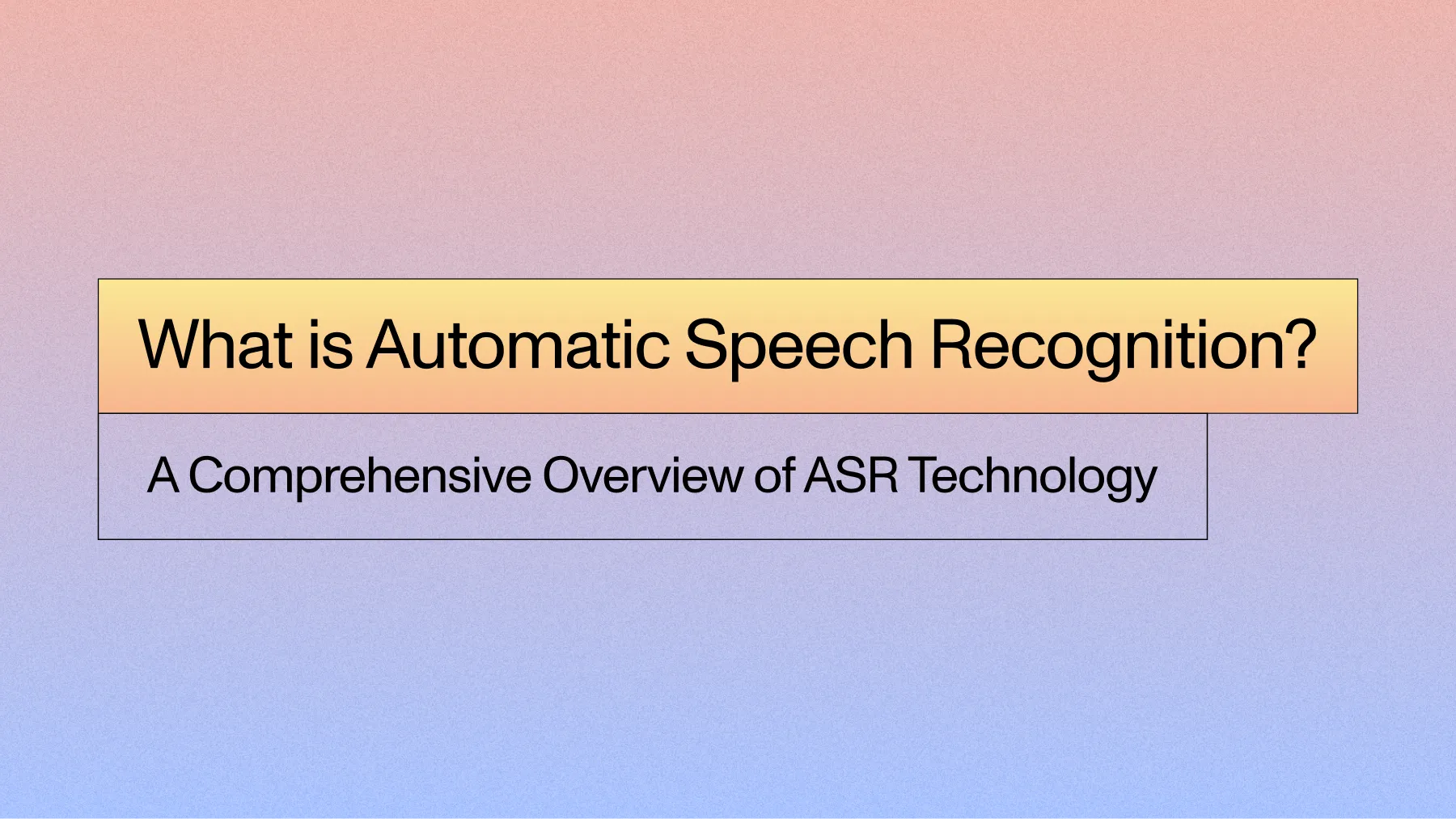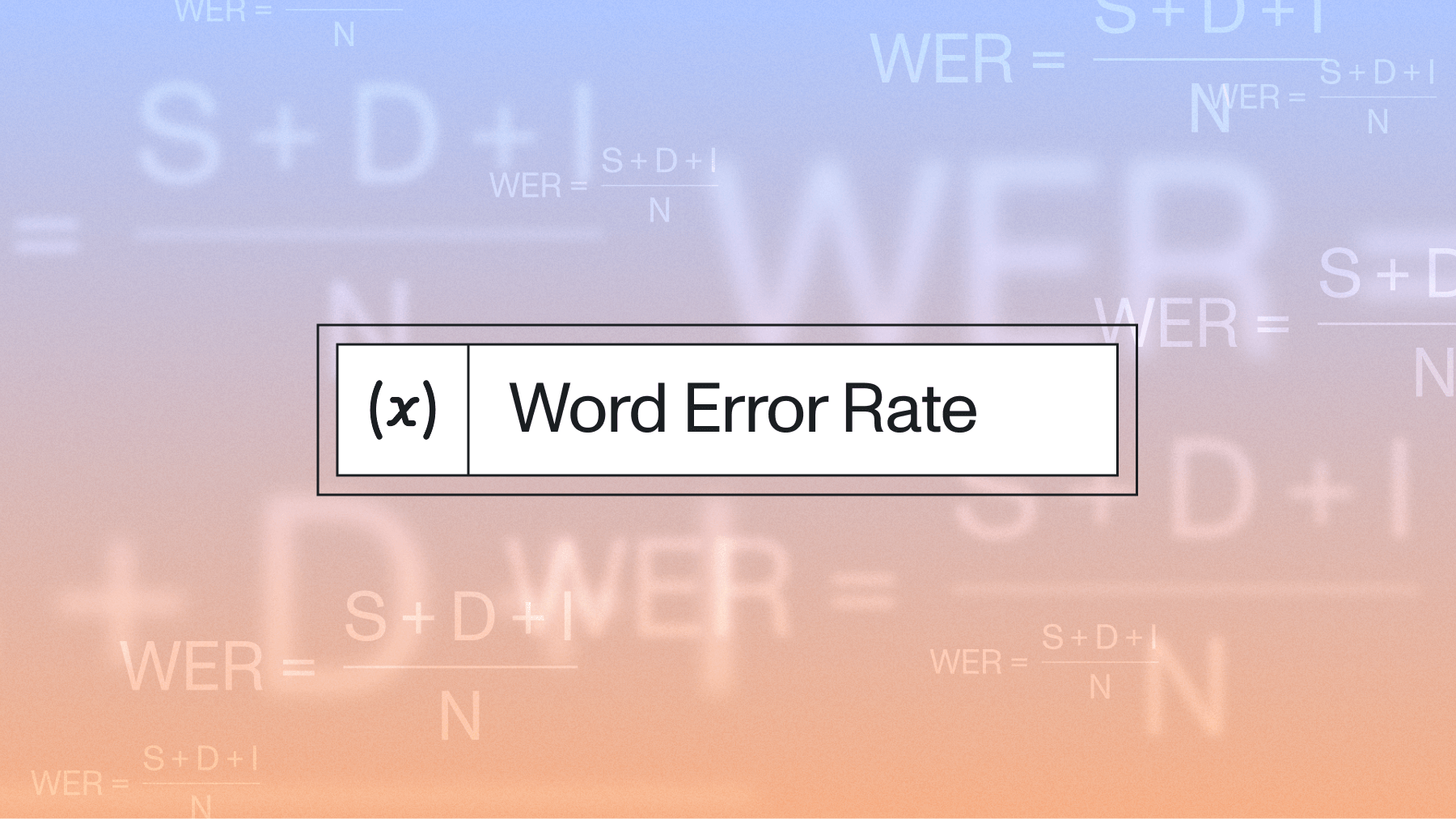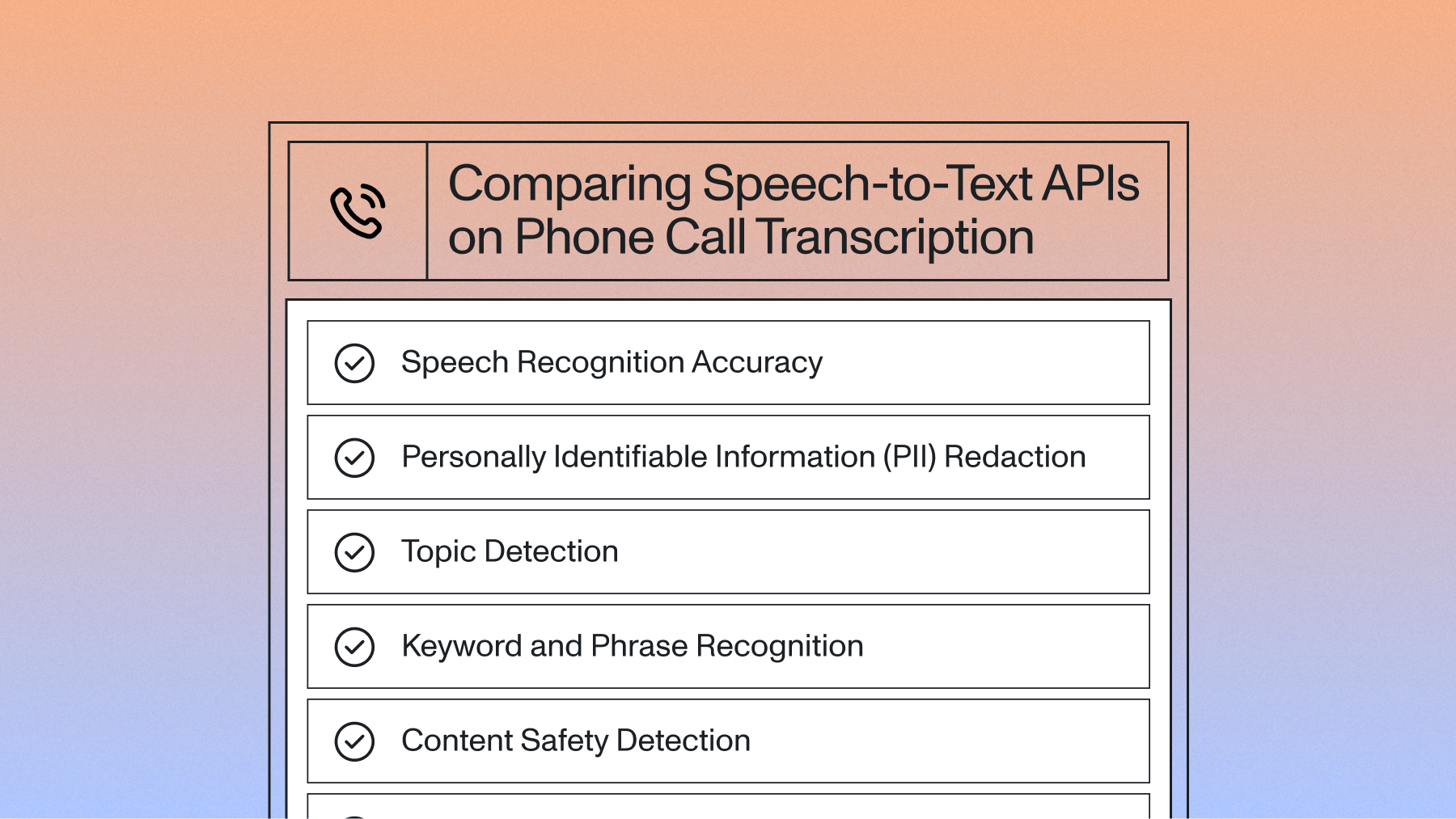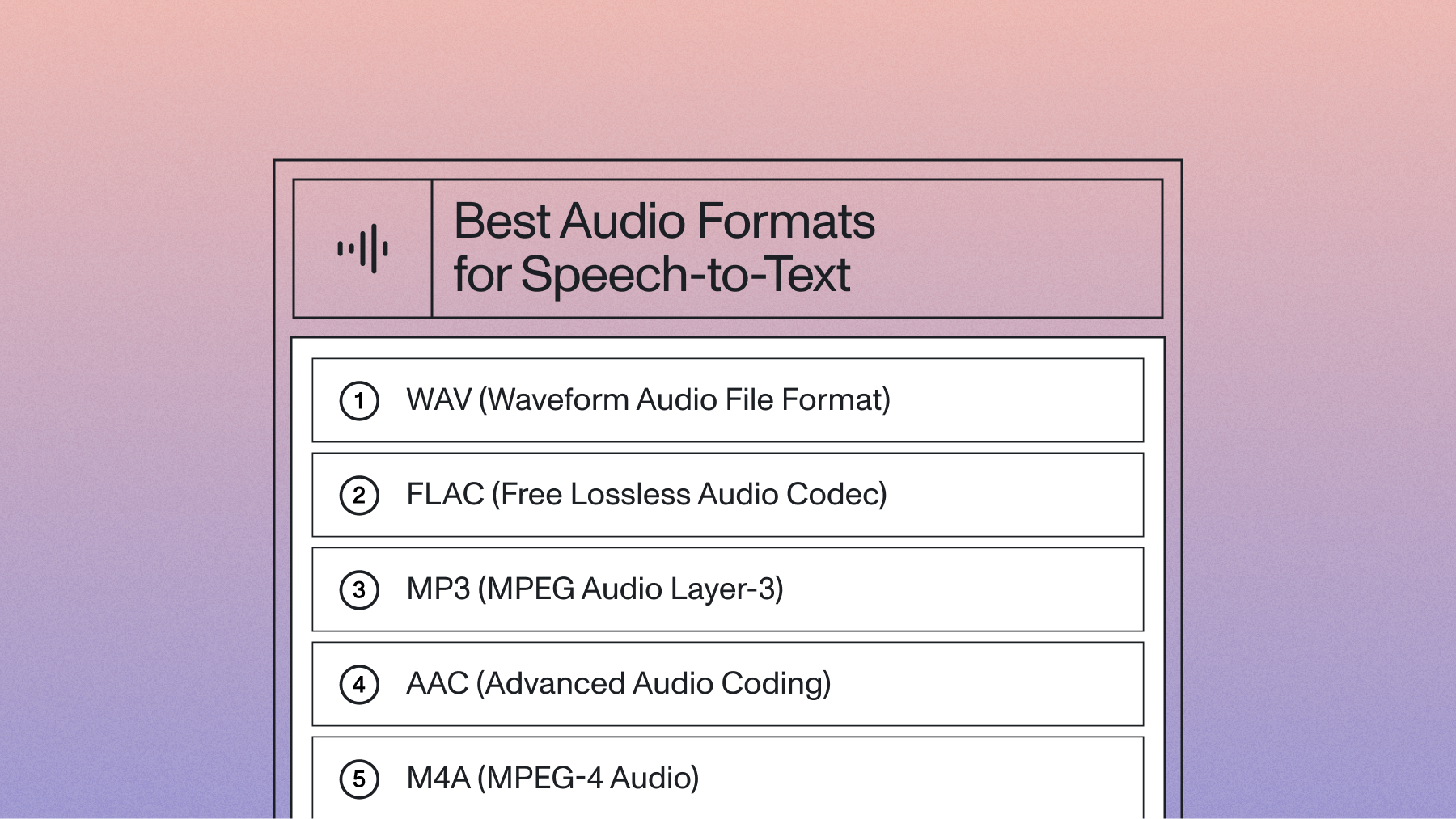What is Automatic Speech Recognition? A Comprehensive Overview of ASR Technology
This article aims to answer the question: What is ASR?, and provide a comprehensive overview of Automatic Speech Recognition technology.



Automatic Speech Recognition, also known as ASR, is the use of AI technology to process human speech into readable text. The field has grown exponentially over the past decade, and market projections show it's expected to reach a market volume of US$73 billion by 2031. ASR systems now power applications we use every day—from TikTok and Instagram's real-time captions to Spotify's podcast transcriptions and Zoom's meeting notes.
As ASR approaches human accuracy levels, we're seeing an explosion of applications taking advantage of this technology to make audio and video data more accessible. Speech-to-text APIs like AssemblyAI are making ASR technology more affordable, accessible, and accurate for developers and businesses of all sizes.
This comprehensive guide covers the fundamentals of Automatic Speech Recognition technology. You'll learn what ASR is and how it evolved, understand the technical approaches that power modern systems, and discover how businesses are using this technology today. We'll also explore current challenges and what's coming next in the field of speech recognition.
What is Automatic Speech Recognition (ASR)? A Brief History
Automatic Speech Recognition (ASR) is AI technology that converts spoken language into written text by analyzing audio waveforms and identifying patterns in human speech. Modern ASR systems can transcribe conversations in real-time with accuracy approaching human-level performance.
Early research confirms ASR extends back to 1952 when Bell Labs created "Audrey," a digit recognizer that could identify spoken numbers, though it required users to pause after each digit. Audrey could only transcribe spoken numbers, but a decade later, researchers improved upon the system so it could transcribe rudimentary spoken words like "hello."
For most of the past fifteen years, ASR was powered by classical machine learning technologies like Hidden Markov Models. Though once the industry standard, accuracy of these classical models had plateaued in recent years.
This plateau opened the door for advanced AI technology that's also powered breakthroughs in self-driving cars. In 2014, Baidu published the landmark paper, Deep Speech: Scaling up end-to-end speech recognition.
The paper's published results, which achieved a 16% error rate on a standard benchmark, demonstrated AI's power in speech recognition and kicked off a renaissance in ASR. This AI-powered approach pushed model accuracy past the plateau and closer to human-level performance.
Not only has accuracy skyrocketed, but access to ASR technology has also improved dramatically. Ten years ago, customers would have to engage in lengthy, expensive enterprise speech recognition software contracts to license ASR technology. Today, developers, startup companies, and Fortune 500s have access to advanced ASR technology via simple APIs like AssemblyAI's speech-to-text API.
Let's look more closely at the two dominant approaches to ASR and understand how they work.
How ASR Works
Today, there are two main approaches to Automatic Speech Recognition:
- Traditional Hybrid Approach: Uses separate lexicon, acoustic, and language models working together
- End-to-End AI Approach: Employs a single unified model that directly maps audio to text
Understanding these differences helps explain why modern ASR systems achieve such impressive accuracy.
Traditional Hybrid Approach
The traditional hybrid approach is the legacy approach to speech recognition and dominated the field for the past fifteen years. Many companies still rely on this approach simply because it's the way it has always been done—there's extensive research and training data available, despite plateaus in accuracy.
Here's how the traditional approach works:
Traditional HMM and GMM Systems

Traditional HMM (Hidden Markov Models) and GMM (Gaussian Mixture Models) require forced aligned data. Force alignment determines where in time particular words occur in an audio segment.
This approach combines three separate models:
- Lexicon Model: Describes phonetic pronunciation of words
- Acoustic Model: Predicts phonemes from audio segments
- Language Model: Predicts word sequences and probabilities
Lexicon Model
The lexicon model describes how words are pronounced phonetically. You need a custom phoneme set for each language, handcrafted by expert phoneticians.
Acoustic Model
The acoustic model (AM) models the acoustic patterns of speech. The job of the acoustic model is to predict which sound or phoneme is being spoken at each speech segment from the forced aligned data. The acoustic model is usually of an HMM or GMM variant.
Language Model
The language model (LM) models the statistics of language. It learns which sequences of words are most likely to be spoken, and its job is to predict which words will follow on from the current words and with what probability.
Decoding
Decoding is a process of utilizing the lexicon, acoustic, and language models to produce a transcript.
Downsides of the Traditional Approach
Though still widely used, the traditional hybrid approach to speech recognition has several drawbacks. Lower accuracy is the biggest challenge. Each model must be trained independently, making them time and labor intensive.
Forced aligned data is difficult to come by and requires significant human labor. Experts are needed to build custom phonetic sets to boost the model's accuracy.
End-to-End AI Approach
An end-to-end AI approach represents a newer way of thinking about ASR, and how we approach ASR here at AssemblyAI.
How End-to-End AI Models Work
With an end-to-end system, you can directly map a sequence of input acoustic features into a sequence of words. The data doesn't need to be force-aligned. Depending on the architecture, an AI system can be trained to produce accurate transcripts without a lexicon model and language model, although language models can help produce more accurate results.
Modern Architectures: CTC, LAS, and RNNTs
CTC, LAS, and RNNTs are popular speech recognition end-to-end AI architectures. These systems can be trained to produce highly accurate results without needing force aligned data, lexicon models, and language models.
Advantages of End-to-End AI Models
End-to-end AI models are easier to train and require less human labor than a traditional approach. They're also more accurate than the traditional models being used today.
The AI research community is actively searching for ways to constantly improve these models using the latest research. There's no concern of accuracy plateaus any time soon—in fact, we'll see AI models reach human level accuracy in the next few years.
Comparing Traditional vs. Modern ASR Approaches
ASR Accuracy and Performance Metrics
Not all ASR systems are created equal. The quality of transcription can make or break user experience.
Word Error Rate (WER) is the industry standard for measuring ASR accuracy. It compares machine-generated transcripts to human-verified transcripts and calculates error percentage.
The formula is simple:
WER = (Substitutions + Deletions + Insertions) / Number of Words in Reference Transcript
A lower WER means higher accuracy. For example, a WER of 10% means that 90% of the words were transcribed correctly.
However, WER doesn't tell the whole story. Real-world audio presents multiple challenges:
- Background noise and poor audio quality
- Overlapping speakers and interruptions
- Unique accents and speaking styles
- Industry-specific jargon and terminology
This is why one ASR system might feel seamless while another feels clumsy. Modern AI models, like AssemblyAI's Universal models, are trained on millions of hours of diverse audio data to perform reliably across these challenging conditions.
ASR Key Terms and Features
Acoustic Model: The acoustic model takes in audio waveforms and predicts what words are present in the waveform.
Language Model: The language model can be used to help guide and correct the acoustic model's predictions.
Word Error Rate: The industry standard measurement of how accurate an ASR transcription is, as compared to a human transcription.
Speaker Diarization: Answers the question, who spoke when? Also referred to as speaker labels.
Custom Vocabulary: Custom vocabulary boosts accuracy for a list of specific keywords or phrases when transcribing an audio file.
Sentiment Analysis: The sentiment, typically positive, negative, or neutral, of specific speech segments in an audio or video file.
See more models specific to AssemblyAI.
Key Applications of ASR
Modern ASR delivers measurable value across diverse industries. Key applications include:
Telephony: Call tracking, cloud phone solutions, and contact centers need accurate transcriptions, as well as innovative analytical features like Conversation Intelligence, call analytics, speaker diarization, and more.
Video Platforms: Real-time and asynchronous video captioning are industry standard. Video editing platforms (and video editors alike) also need content categorization and content moderation to improve accessibility and search.
Media Monitoring: Speech-to-text APIs can help broadcast TV, podcasts, radio, and more quickly and accurately detect brand and other topic mentions for better advertising.
Virtual Meetings: Meeting platforms like Zoom, Google Meet, WebEx, and more need accurate transcriptions and the ability to analyze this content to drive key insights and action.
Choosing a Speech-to-Text API
With more APIs on the market, how do you know which speech-to-text API is best for your application?
When considering which API to use, one insights report found that the top factors for buyers are cost, quality, accuracy, and ease of use. Key considerations to keep in mind include:
- How accurate the API is
- What additional models are offered
- What kind of support you can expect
- Pricing and documentation transparency
- Data security
- Company innovation
Companies like Aloware use highly accurate ASR to power smart transcription and speed up QA for their customers. CallRail doubled its Conversational Intelligence customers by integrating AI-powered ASR into its platform and building powerful Generative AI products on top of the transcription data. Marvin added AI transcription to build a suite of AI-powered tools and features that resulted in significantly less time analyzing research data for its customers.
Challenges of ASR Today
One of the main challenges of ASR today is the continual push toward human accuracy levels. While both ASR approaches—traditional hybrid and end-to-end AI—are significantly more accurate than ever before, neither can claim 100% human accuracy. There's so much nuance in the way we speak, from dialects to slang to pitch.
Even the best AI models can't be trained to cover this long tail of edge cases without significant effort. Some think they can solve this accuracy problem with custom speech-to-text models. However, unless you have a very specific use case, like children's speech, custom models are actually less accurate, harder to train, and more expensive in practice than a good end-to-end AI model.
Another top concern is speech-to-text privacy for APIs. In fact, a recent industry survey found that over 30% of respondents cited data privacy as a significant challenge, as many large ASR companies use customer data to train models without explicit permission. Continual data storage in the cloud also raises concerns over potential security breaches, especially if raw audio or video files or transcription text contains Personally Identifiable Information.
On the Horizon for ASR
As the field of ASR continues to grow, we can expect to see greater integration of speech-to-text technology into our everyday lives, as well as more widespread industry applications.
We're already seeing advancements in ASR and related AI fields taking place at an accelerated rate. Examples include OpenAI's ChatGPT, HuggingFace spaces and AI applications, and AssemblyAI's Universal model.
In regards to model building, we also expect to see a shift to a self-supervised learning system to solve some of the challenges with accuracy discussed above.
End-to-end AI models are data hungry. Our Universal model at AssemblyAI, for example, is trained on millions of hours of raw audio and video training data for industry-best accuracy levels. However, obtaining human transcriptions for this same training data would be almost impossible given the time constraints associated with human processing speeds.
This is where self-supervised AI systems can help. Essentially, this is a way to get an abundance of unlabeled data and build a foundational model on top of it. Then, since we have statistical knowledge of the data, we can fine-tune it on downstream tasks with a smaller amount of data, making it a more accessible approach to model building.
This is an exciting possibility with profound implications for the field. If this transition occurs, expect ASR models to become even more accurate and affordable, making their use and acceptance more widespread. Ready to experience the power of modern ASR technology? Try our API for free and see how accurate speech recognition can transform your applications.
Frequently Asked Questions About Automatic Speech Recognition
What is the difference between ASR and NLP?
ASR converts spoken audio into written text, while NLP analyzes that text to understand meaning, intent, and sentiment. Think of ASR as the ears and NLP as the brain—they work together in Voice AI applications.
Is ASR the same as speech-to-text?
Yes, ASR and speech-to-text are used interchangeably. ASR is the underlying technology, while speech-to-text describes the function it performs.
What is the difference between speech recognition and voice recognition?
Speech recognition transcribes what is being said, while voice recognition identifies who is speaking by matching unique voiceprints. Speech recognition creates transcripts; voice recognition labels speakers.
Is ASR a form of AI?
Yes, modern ASR uses AI models to convert human speech into text. The most advanced ASR systems use sophisticated AI architectures that continuously learn and improve from vast amounts of audio data.
How accurate is modern ASR compared to humans?
Modern ASR systems achieve Word Error Rates below 5% on clear audio, approaching human-level accuracy in ideal conditions. Performance varies with background noise, accents, and overlapping speakers, where humans still maintain advantages in contextual understanding.
Lorem ipsum dolor sit amet, consectetur adipiscing elit, sed do eiusmod tempor incididunt ut labore et dolore magna aliqua. Ut enim ad minim veniam, quis nostrud exercitation ullamco laboris nisi ut aliquip ex ea commodo consequat. Duis aute irure dolor in reprehenderit in voluptate velit esse cillum dolore eu fugiat nulla pariatur.





